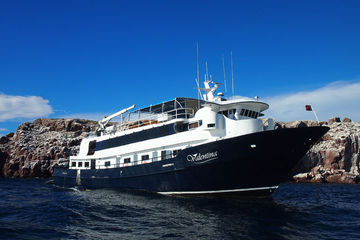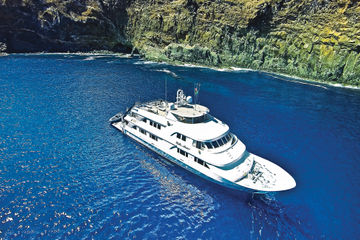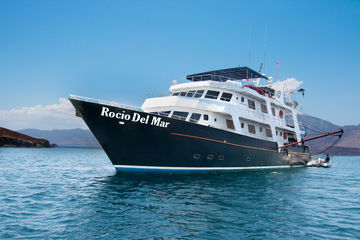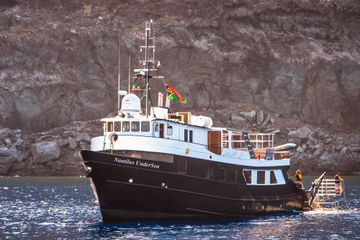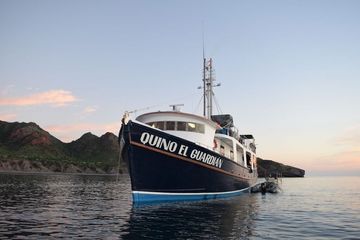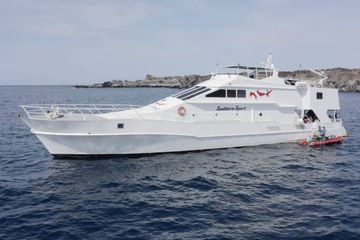Popular San Jose Del Cabo liveaboards Explore all liveaboards
Liveaboard Diving in San Jose Del Cabo
What to expect On a San Jose Del Cabo liveaboard
San Jose del Cabo liveaboards allow divers to explore the sparkling turquoise seas and an incredible abundance of marine life in Mexico. As the gateway to the Socorro Islands, liveaboard diving from San Jose del Cabo is a great choice. The climate is also very appealing with sea temperatures ranging from 22 to 29 degrees Celsius and outside temperatures reaching up to the mid-thirties in summer. San Jose del Cabo liveaboards are the best way to explore the Pacific side of Mexico.
Liveaboard Diving from San Jose del Cabo
Several San Jose Del Cabo liveaboards depart from here to the Revillagigedo Archipelago, also known as the Socorro islands, a group of 4 uninhabited islands 400km from the coast of Mexico in the Pacific Ocean. These liveaboards only travel in the months of November to May, as otherwise, it is not the correct season.
Each of the Socorro islands has its own gems to see. San Benedicto Island is generally the first stop; it is the most popular area for coming up and close with Giant Pacific Manta Rays; there is a famous cleaning station named The Boiler. You will see multiple curious Mantas with a wingspan of up to 8m (24ft). Socorro, the most well-known of the four islands, is a pelagic paradise. From January till March, you can swim with Dolphins; from January till April, there are thousands of Humpback whales in their breeding season, and throughout the year, there are numerous Manta Rays and sharks; Silky, Galapagos, white tip, and silvertip sharks. Roca Partida is the smallest island of the four, a pinnacle that attracts large schools of Jacks and Tuna; the small crevices inhabit many smaller species, and at around 13m (40ft), some caves inhabit multiple sharks. A really diverse ecosystem. Lastly, the island of Clarion, which is located the furthest out, is an island made up of three volcanic peaks; it has its own Angelfish named after the island, the Clarion Angelfish is often seen cleaning the large pelagic species. From January till April, you will also see Humpback whales swim past here.
These Pacific Ocean dive sites should be expected to have colorful and flourishing reefs, the focus point here is the abundance of large and impressive marine species. These sites are only accessible by San Jose del Cabo liveaboard, which means privacy and a unique experience.
Getting to San Jose del Cabo
San Jose del Cabo is in Baja California, in the most Southern municipality of Los Cabos. You will most likely fly into Los Cabos International Airport, which has flights from the United States, Canada, and other Mexican Cities. The Mexico liveaboard will dock at the marina in Pueblo la Playa San Jose del abo, which is around 25 minutes from the airport. The city's center, where most hotels are located, is 10 minutes from the marina and 15 from the airport. Most of the liveaboards will depart in the evening as it takes an entire night to get to Socorro.
San Jose Del Cabo Diving Reviews
- 9.8 Exceptional
- 5 Verified Reviews
Cabo diving itself is cold (67 degrees F) with low visibility (10ft) and can be very crowded/touristy. Saw some interesting macro life, but no big creatures.
Diving San Jose Del Cabo in May on the Nautilus Belle Amie
Limited visibility but sightings of hammerheads and mobula rays, as well as humpbacks on the surface.
Diving San Jose Del Cabo in January on the Nautilus Explorer
Pacific diving, nothing stood out on my two dives out there.
Diving San Jose Del Cabo in March on the Nautilus Belle Amie
Only Gordo Banks really worthwhile - if lucky.
Diving San Jose Del Cabo in March on the Valentina
Visibility a bit poor but lots of sightings of mantas, sharks and dolphins.
Diving San Jose Del Cabo in January on the Rocio del Mar
